Using Catalog Ads as a Home & Lifestyle brand
February 6, 2024
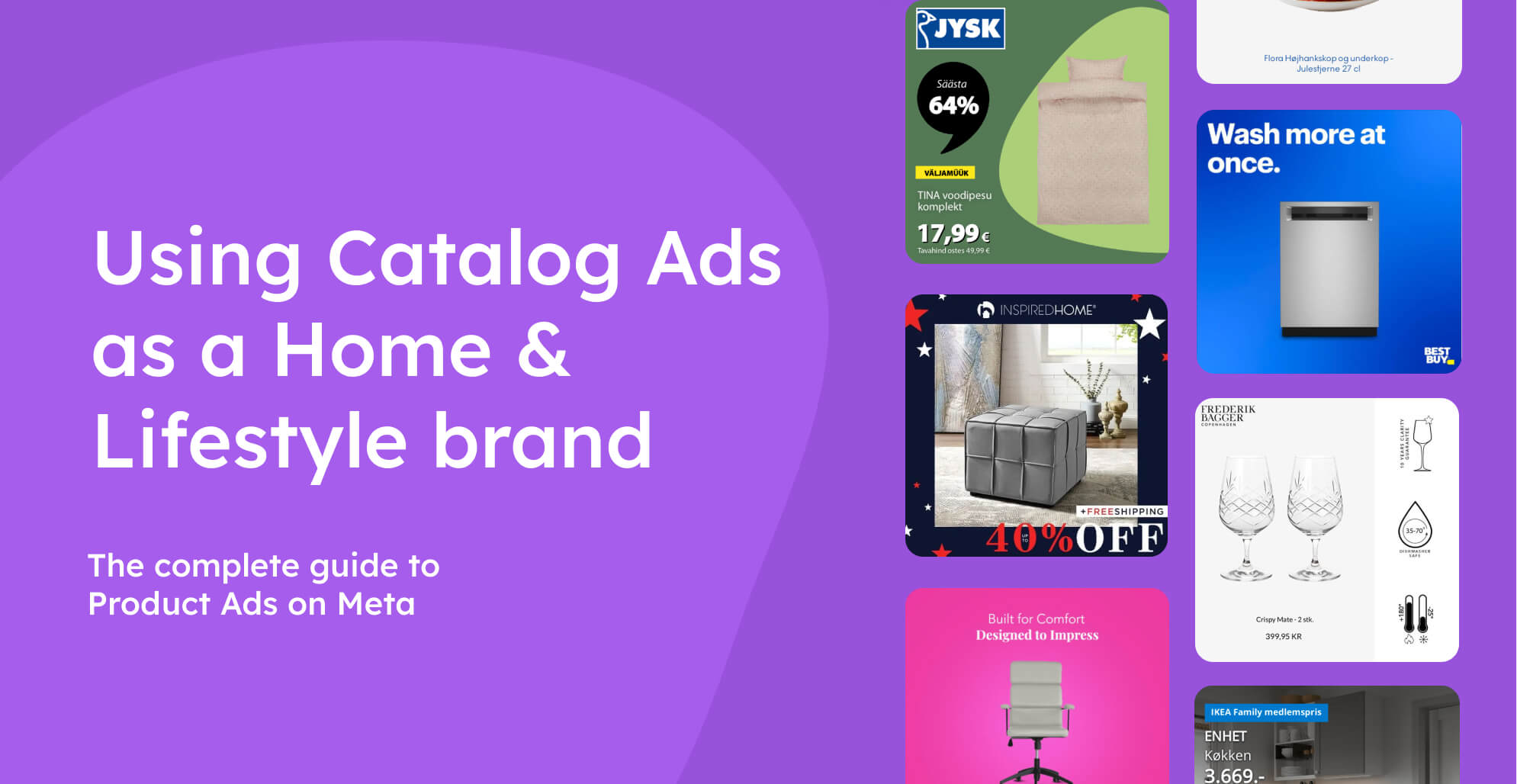
Whether your business sells furniture, appliances, home decor, bedding, or anything else that you'd find in the home, this guide is built just for you!
We've built the following playbook as a comprehensive source of inspiration for home and/or lifestyle brands---just like yours---so that you can amp up your Catalog Ads to reach their full potential!
Below, you'll find a refined list of some of the BEST home brand ads, which we'll dissect to explain just WHY they're so effective at getting people to pay attention to them.

Of course, not every tactic is going to be right for your home or lifestyle brand, your products, or your Catalog Ads.
But you should use the following playbook as a source of inspiration, using the tactics and strategies that make the most sense for your brand!
So, if you are a home or lifestyle brand, and you want to make the most of every dollar you spend on online advertising, you MUST keep reading!
Let's go!
The most used product fields in Catalog Ads designs:
The moderately used product fields in Catalog Ads designs:
The rarely used product fields in Catalog Ads designs:
Table of Contents
Always-on Catalog Ads for home brands
Your always-on ads are, well, always-on. So, it's super important that you make sure they're living up to their full potential.
These are the Catalog Ads that you're running at all times, which means they're the ads that your audience will see the most often. They're also where you're probably investing the most of your ad spend.
So that's why you should put the most time, energy, and focus into designing, A/B testing, and tweaking these ads.
But how exactly can you ensure your always-on Catalog Ads live up to their full potential?
Showing your logo for home brands
As any business owners knows, your logo is one of the most important parts of your branding.
Good logos are unique, eye-catching, and representative of your business. They're also memorable, so that people will always think of your products when they see it.
So showing a logo in your ads can be a powerful tool for Home & Lifestyle brands and retailers. In fact, we've found that showing the advertiser's logo in Catalog Ads can boost performance by as much as 43%!
That said, logos alone aren't the magic sauce that turns bad ads into good ads... But showing them, when appropriate, can help!
So let's take a look at a couple examples of home and lifestyle brands that use their logos to amp up their ads.
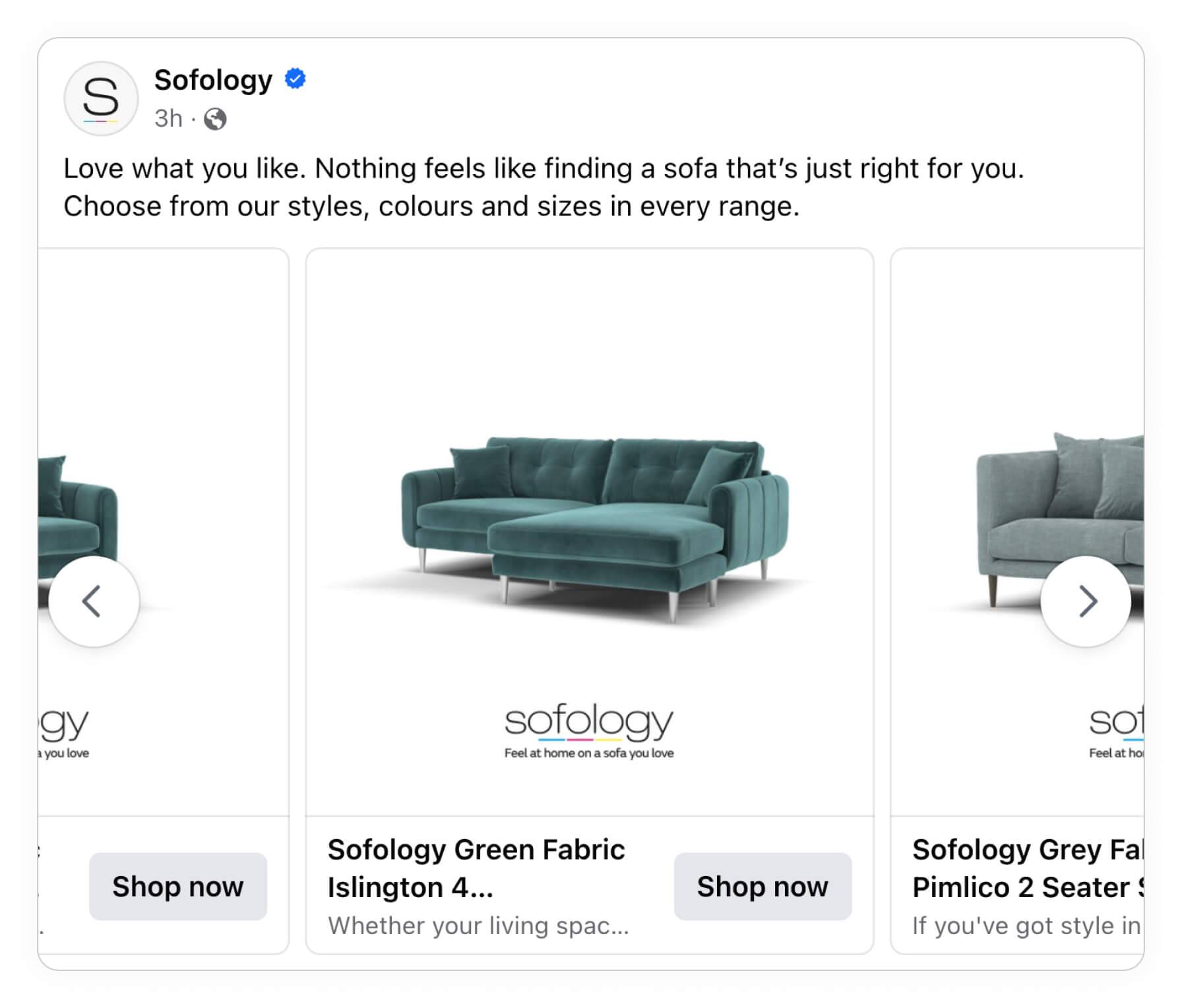
Of course, you should do it the way that fits your home brand, and your logo too, of course. But, sometimes, simple is the way to go! Just like Sofology did in their simple, yet elegant Catalog Ads.
The ads are simple and clean, and the logo really pops thanks to the high-contrast of the bright white background. They show their audience that these products are indeed from them. And even the 99% that do not buy anything from the ad will remember them and their products the next time they see that logo!

Here's another way to show your logo! Ideally, you would use colors that are on-brand for your home or lifestyle business, which can help people remember you in the future. You can even get crafty by using different bits of color theory to make your ads even more compelling. After all, different colors can be used to evoke different feelings and emotions into your viewers.
But this brand stepped things up even more by including a string of text to give the viewer even more information. Remember that a logo alone isn't going to be enough to get people to buy (unless you're a high-end retailer, then this might sometimes be enough.) So, including some text alongside your logo can be a great way to go!

Just remember that your brand assets, like your logo, really are your friend! And when used the right way, they can really make your Catalog Ads more recognizable and effective than before.
Benefits:
- Showing your logo can boost Catalog Ad performance by as much as 43%.
- Logos can help build trust and brand recognition for the future.
- Including some text in your Catalog Ads alongside your logo can help provide viewers with relevant information.
Disadvantages:
- Showing your logo won't work if your brand isn't well-known.
- In some cases, showing your logo has been proven to harm Catalog Ad performance.
Leveraging prices & product information for Home & Lifestyle brands
Prices are, in some (most) cases, one of the most obvious and easiest things to add to your always-on Catalog Ads setup.
And, we've actually found that including prices in eCommerce ads can boost performance by as much as 25%!
This is mostly because knowing price makes the decision to buy or not to buy that much easier for the viewer.
However, if your brand sells more expensive, higher-end products, including the price probability isn't a good idea. On the other hand, for mid to lower-end products, including price will help simplify the buyer's journey.
But, pricing psychology is a fine art, and there's a ton of different ways that home and lifestyle brand can show prices.
For example, take a look at the following ad from H&M, where they've included the price, alongside their logo, the products' name, and wrapped it all up together in a well-designed frame.
By including the price alongside other product information, they're giving the viewer ALL the information the buyer might be looking for in one place. Essentially, this helps make the decision of whether or not buy anything just that much easier for the viewer. In other words, showing the RIGHT information can help qualify your viewers before they click on your Catalog Ads!
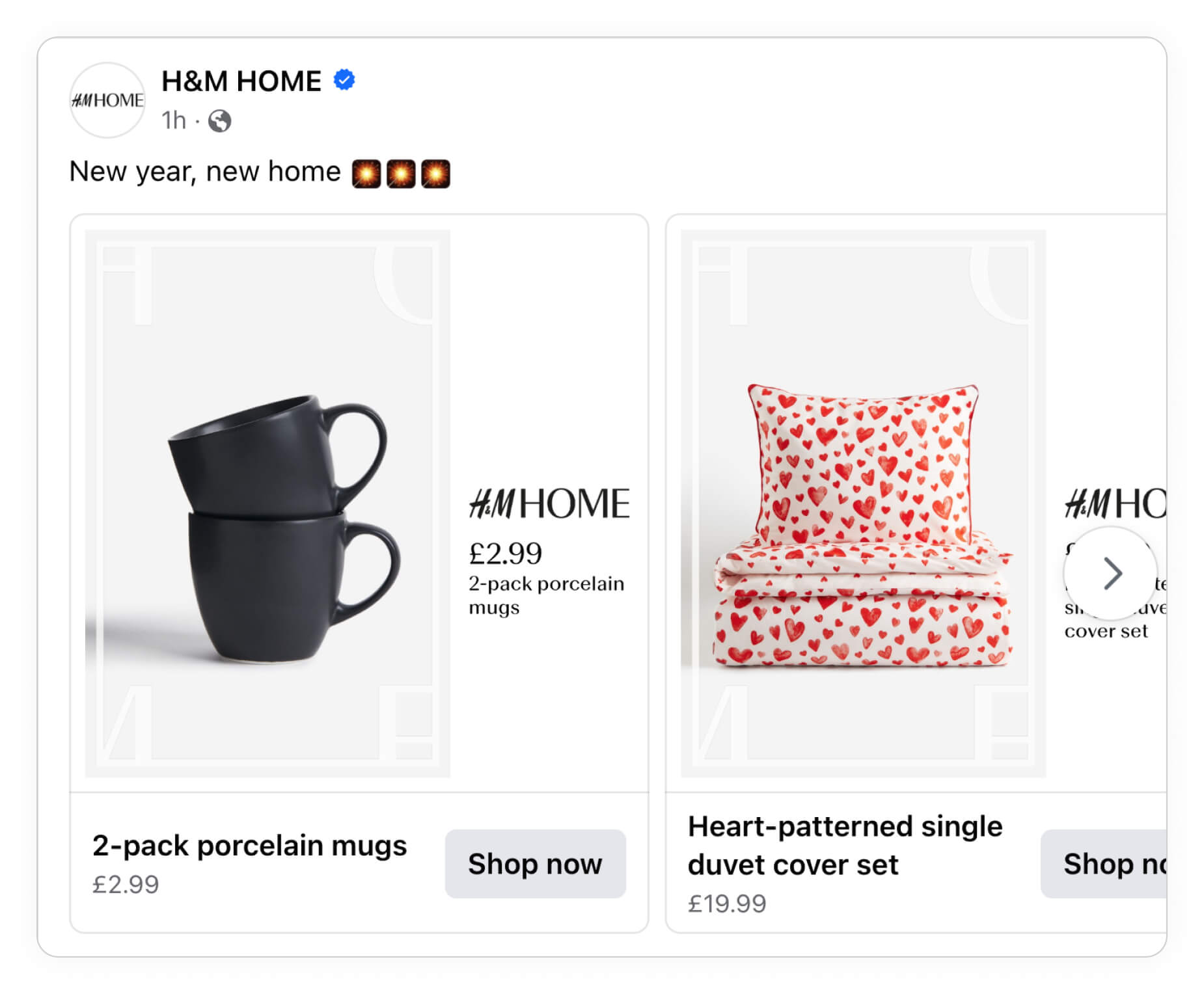
Below, we have another example where the advertiser showed the price, alongside other important product information, which helps viewers decide whether or not these products are for them, without even needing to click on anything to find out.
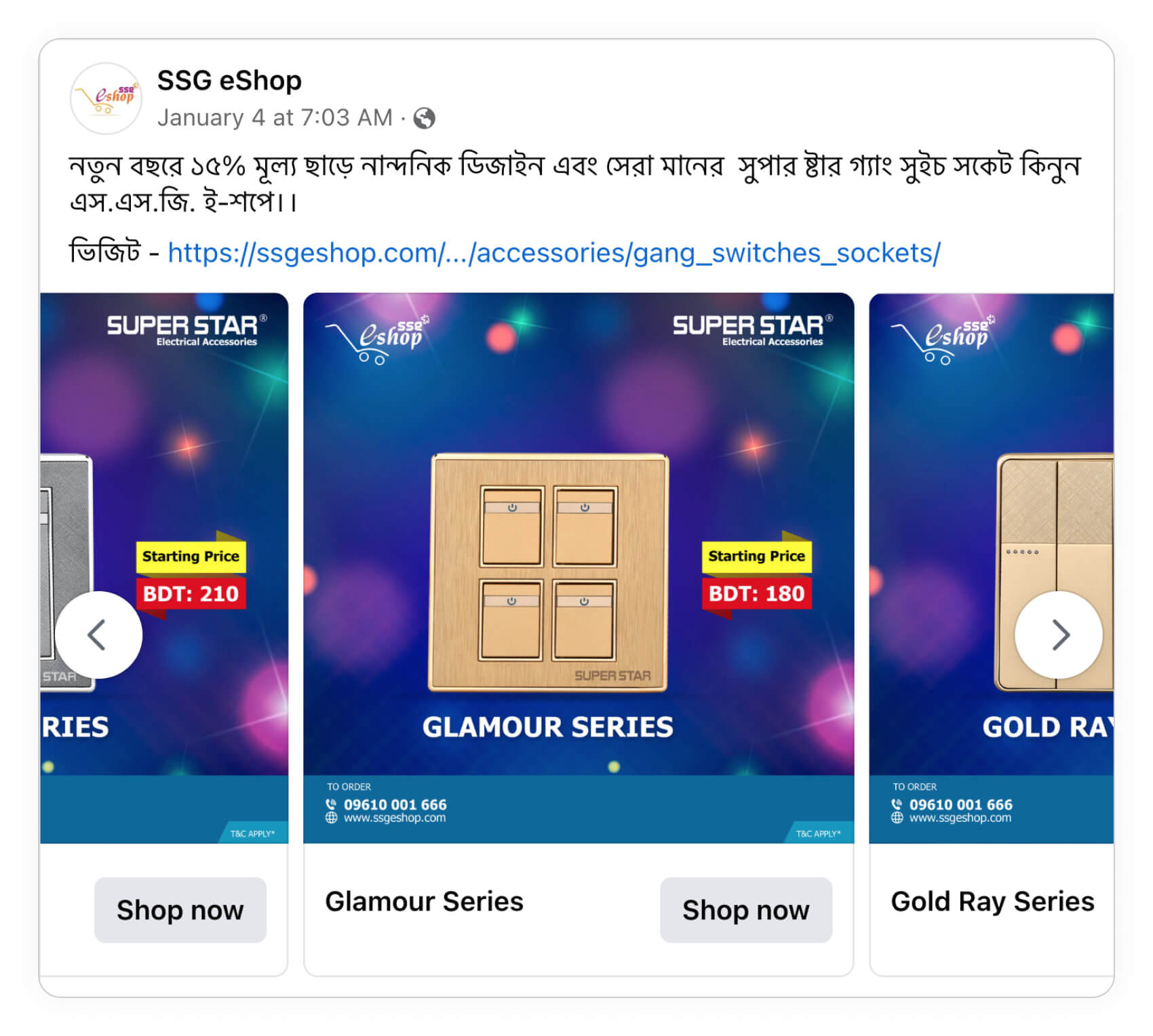
And again, we have an ad from NEXT, where they've combined price and product information, but they're stepped things up even further by showing lifestyle images of how their products might look in your home! Obviously, not every home brand has the resources or the images of this, but if you do, showing lifestyle images can be absolutely genius!

Now, let's recap the pros and cons of using pricing and product information to make your home and lifestyle ads that much better.
Benefits:
- Including pricing information can boost Catalog Ad performance by up to 25%
- Pricing and product information can work to qualify your viewers, leading to better quality traffic on your site.
Disadvantages:
- Including too much information can make your Catalog Ads look cluttered and feel overwhelming.
So we hope these examples help illustrate that there are different ways to combine prices and product information. But that brings us to another bit of information you can play around with too:
Showing home and lifestyle product names
Again, product names alone aren't going to sell your products. And in some cases, we've actually found that showing a products name can decrease performance by as much as 30%.
However, it depends on the type of products your selling.
So if you're selling tech products, for example, it's important to tell your viewer exactly what product and model they're looking at. But if you're selling bedding, curtains, or furniture, the product's name might not add much relevance for your viewer.
That said, there are times when it makes sense to show your viewers this information.
Just like the following ad example, where the focus is on the exact type of chair for executives. In this case, they know their ideal buyers are looking for higher-end, executive-style chairs. So, including the names of the products can be considered vital information.
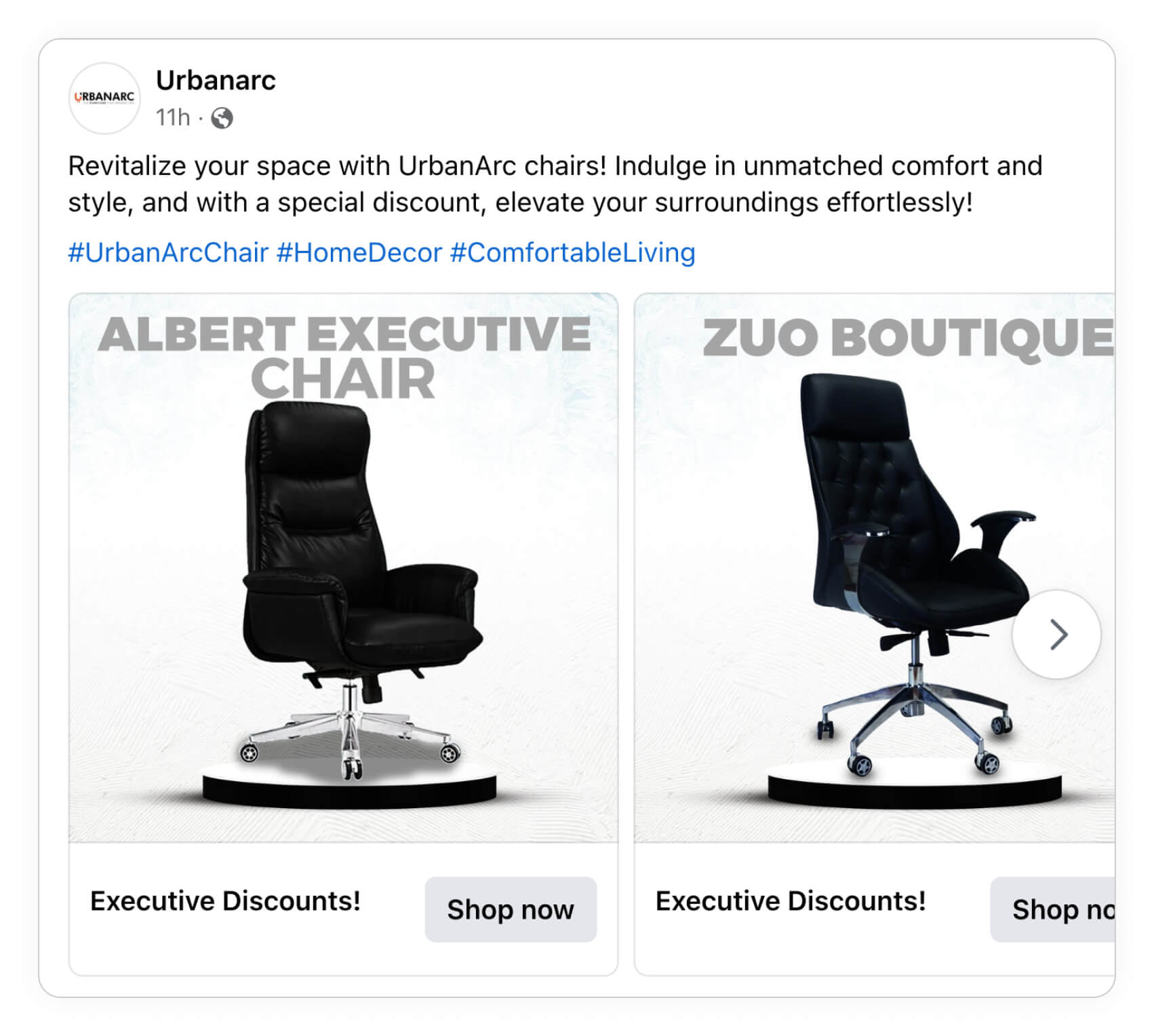
Including a product's name might also make more sense if you're including other relevant information, such as the brand, country of origin, or other Unique Selling Points. Just like the following example, where the advertiser shows the product name, and the brand's logo alongside lifestyle images of the products in real life.
The trick is including RELEVANT information, which should add value to the viewers' experience of seeing your Catalog Ad!

You can also include product names combined with different colors, just like in the following ad. One nifty trick would be to use your brand's colors as the product's name font, which should help bring your ads together into a more cohesive theme.
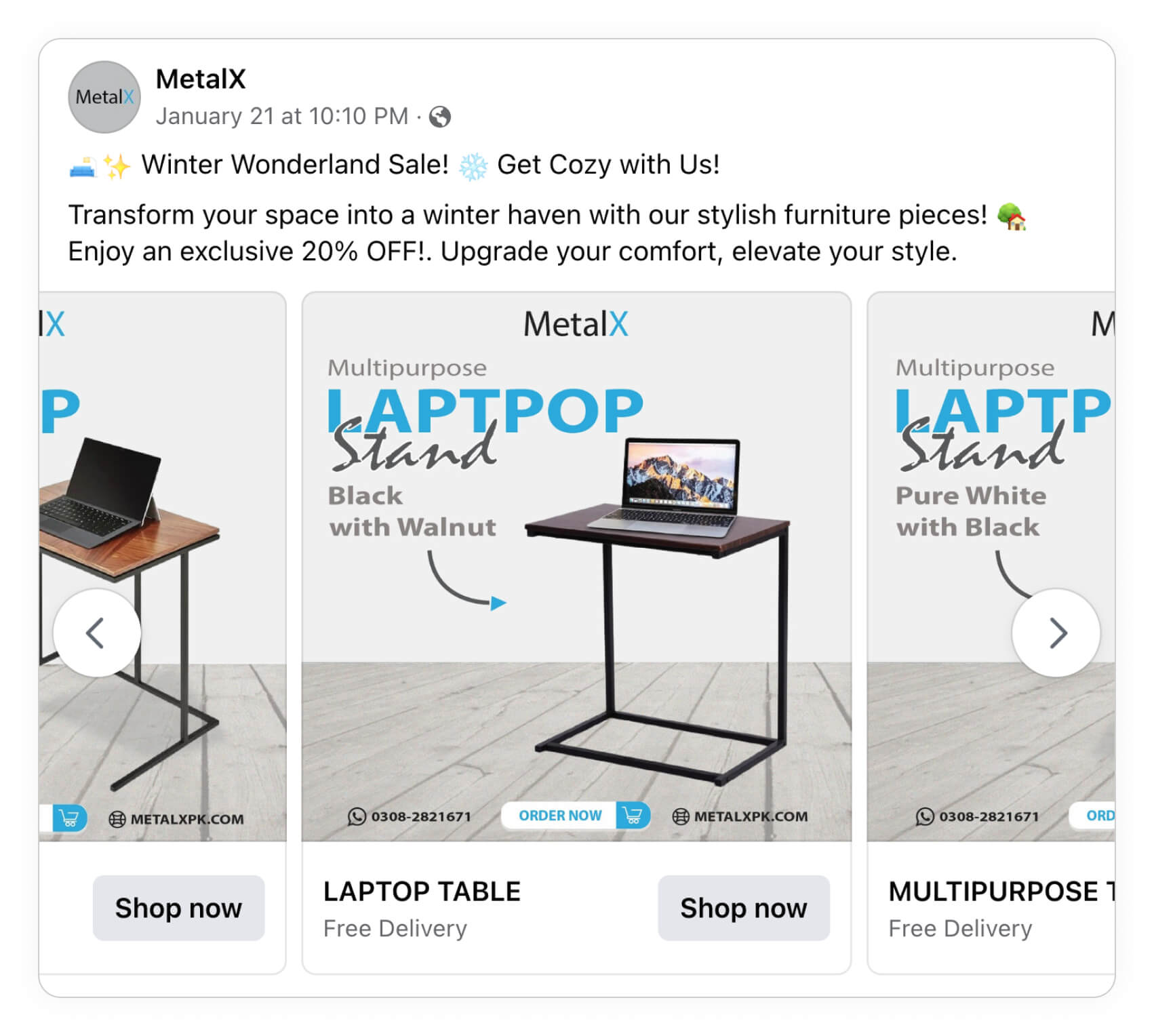
Essentially, the idea here is to take readily available information about your home or lifestyle products, but to brand it so that it's more relevant to your business.
Benefits:
- Depending on what type of home products you're selling, the products' name might be important information for the viewer.
- When combined with other relevant information, product names can help illustrate who your ideal buyers really are.
Disadvantages:
- Showing a products name alone won't necessarily boost performance.
- Including product names can sometime decrease your Catalog Ad performance.
Using features, specs, social proof, and more for home & lifestyle brands
When it comes to your always-on Catalog Ads, the main takeaway so far has been to show your viewer the RIGHT information, which can be logos, prices, or product names.
But that's not everything!
You can also use product features or specs to help make your ads even more relevant. The idea here is that you can use product information and data that you already have to make your home product Catalog Ads that much more compelling to your target audience.
Just like the following ad from Famco, where they show the product's dimensions, and include a few other unique selling points in the bottom corner of the ad.
Talk about giving your viewers the information they want! Genius! Again, including all this information helps to not only describe the product, but to screen and qualify who the ideal buyer really is.
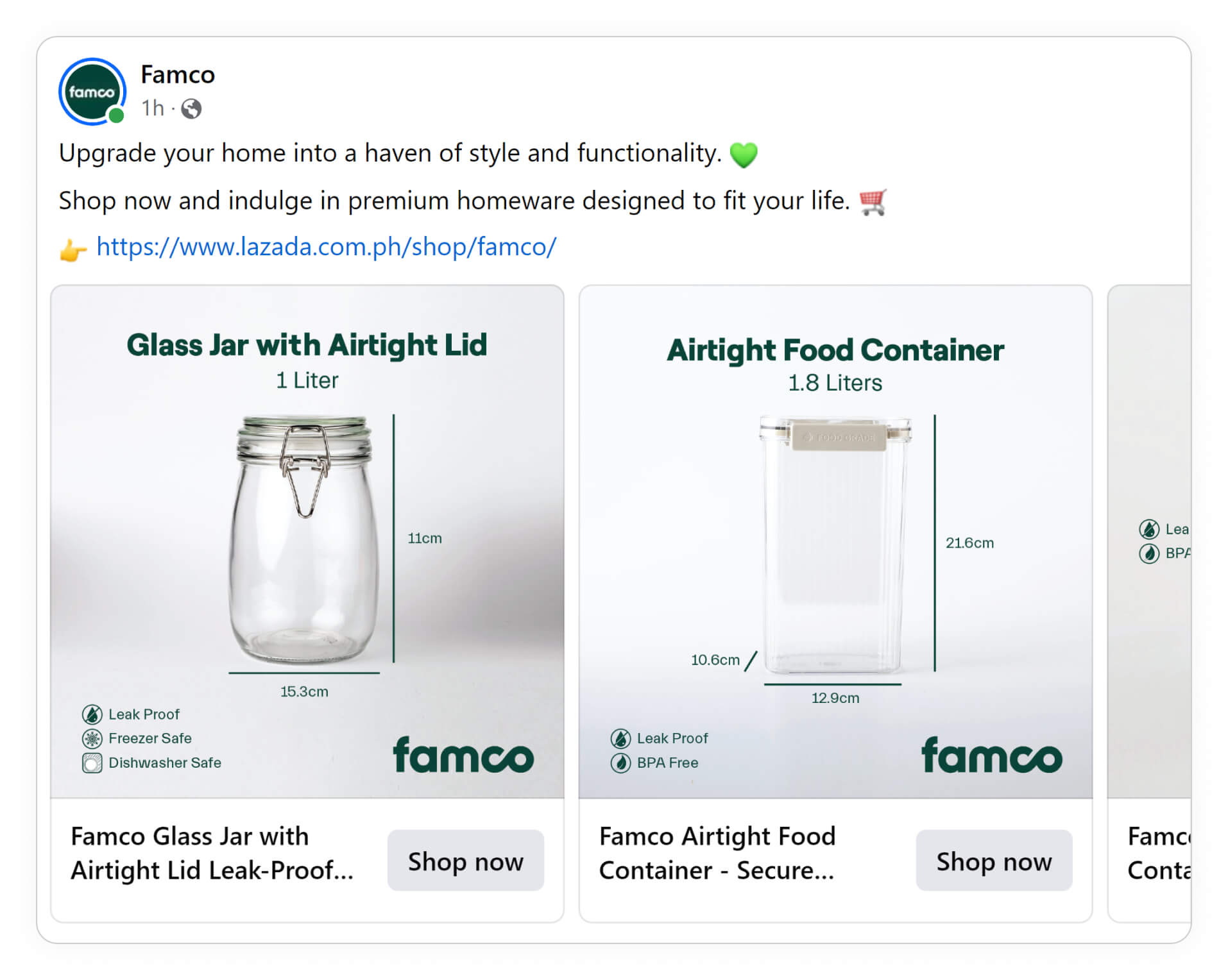
Of course, depending on the data you have or the products you're selling, not every home brand can show dimensions like this. Fortunately, you can still do some cool stuff with your home or lifestyle Catalog Ads, even without having specific measurements or dimensions available.
For example, the following ad from Patch Plants uses TrustPilot ratings as a form of social proof to help make their Catalog Ads more unique and more appealing to viewers. Social proof can be a powerful tool for making your home brand's product more trustworthy and desirable. Especially when using social proof from high-quality, reliable sources, it's just like saying: "Our products are good enough for these people. They should be good enough for you too!"
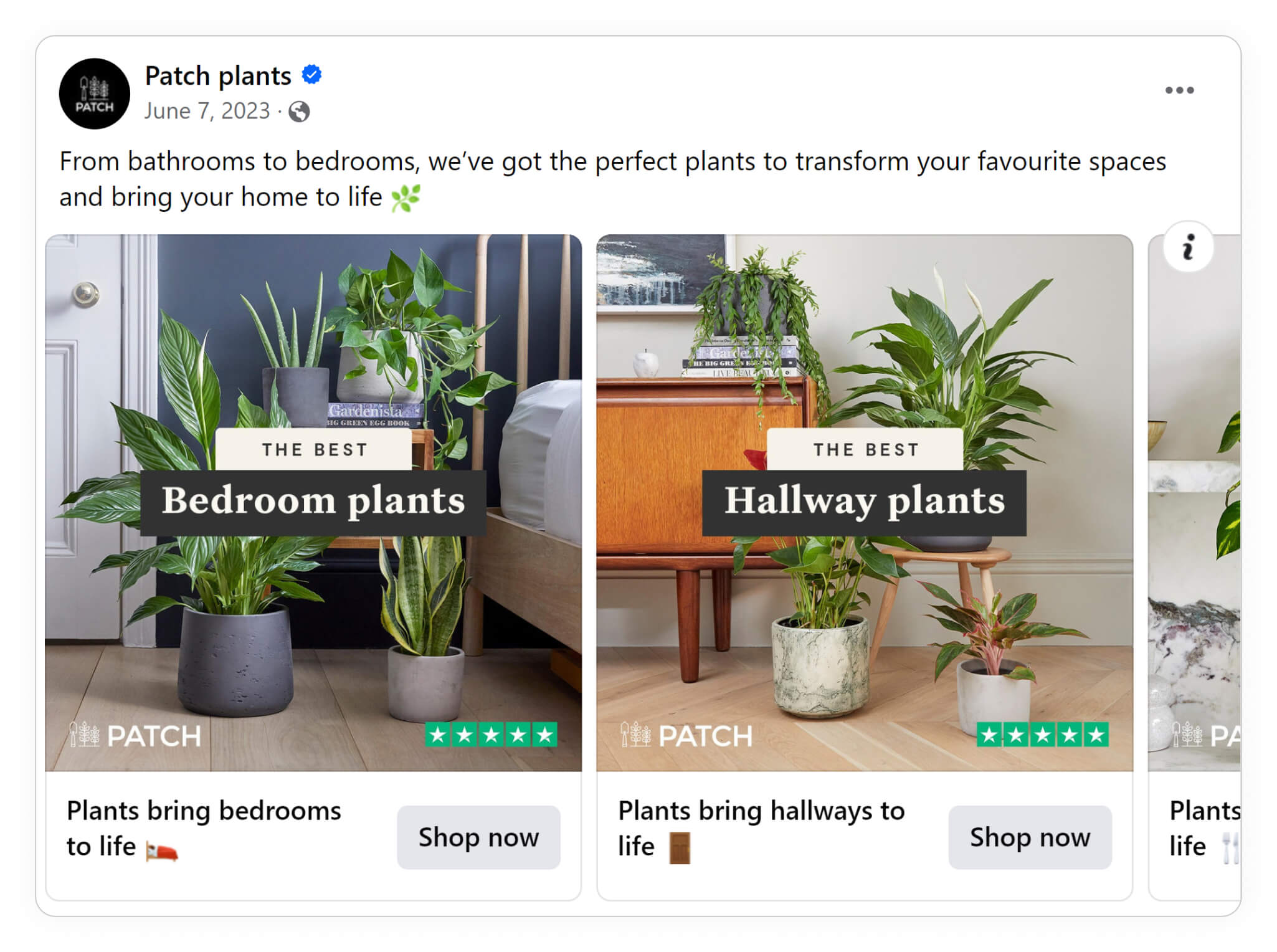
You could also use different information, such as a product's type or category to provide viewers with the right info. Just like the following ad, which doesn't show multiple different categories, but provides a category title to help viewers know what type of product they're looking at.

Again, the idea is just to use information you already have to provide your viewers with information they'll want and need to see before they make a decision on whether or not to shop through your products.
Benefits:
- Product features, specs, and other attributes can help make your Catalog Ads more relevant.
- Social proof can be a powerful tool for building trust in your home brand and its products.
Disadvantages:
- Including too many product attributes can make your Catalog Ads look and feel cluttered.
Campaigns & Sales for home brands
Campaigns can be a great way to have sales that drive a sense of urgency into your Catalog Ads viewers. Especially when having limited-time-only sales, these types of campaigns can really help ramp up your revenue.
But just like with home product information, there are all sorts of different ways you can use campaigns and sales to boost your ad performance.
Let's take a look!
Campaign periods for home brands
Campaign periods can be used to create sales around specific times of year, such as Christmas, Easter, Halloween, or Black Friday. And the following ads are great examples of how some home brands are doing just that!
But you don't need to only focus on major holidays like Christmas! If you are operating in markets with a large Muslim population, for example, then Eid al-Fitr can be a great way to make your sales more relevant to the time of year. This is also a good example to show that no campaign period is too little or not popular enough to celebrate.

Below we have an example from IKEA that uses different categories for different sales. Overall, this is just a great way to simplify your sales campaign for holiday hosting; this shows you don't have to plaster your design in Christmas colors to actually participate in a campaign period! Be true to your brand.

And, of course, this section wouldn't be complete without showing an ad example that uses seasons for a sales period. Interestingly, you can always pair campaigns or seasonal sales with other home product information as well or use pricing psychology or color theory to make your ads' themes that much more relevant.

On that note, let's recap a what we can takeaway from creating time-based campaigns for your home and lifestyle brand.
Benefits:
- Campaigns can create a sense of urgency, which can drive your audience to act now, rather than miss out later.
- Campaigns can be create around all sorts of different time periods, holidays, events, or product categories.
Disadvantages:
- Time-sensitive campaigns won't last forever, which means that you'll need to update your Catalog Ads more often.
Just remember that there are all sorts of different campaigns you can create, from religious holidays, to specific times of the year. So don't be shy to think outside the box, and try different campaign ideas that are new, relevant, and unique to your brand!
Boosting ad performance for home and lifestyle brands
So there you have it! Our comprehensive guide on using Catalog Ads for Home brands.
Of course, these are only a handful of examples to highlight what home brands are doing to draw in more attention to their products and sales. And there really are a ton of different ways you can combine this information to amp up your own hands.
However, the key takeaways are that you want to show your viewer information that is important and relevant to them.
Logos, pricing, product names, and other similar information can be great ways to do that!
Just remember, though, that you should always A/B test your ads to find out what does and what doesn't work!
